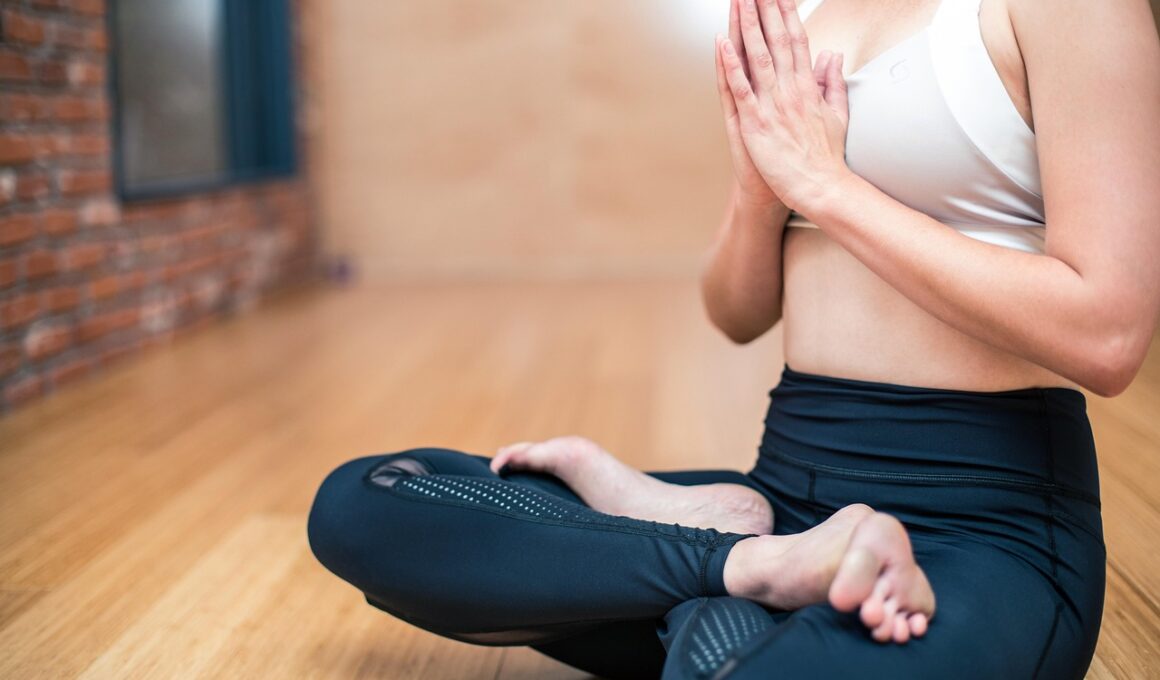Flexibility Challenge with Pilates: Strength and Mobility Combined
Pilates has gained immense popularity for promoting flexibility, strength, and overall well-being. This flexibility challenge through Pilates connects body and mind. Every movement is intentional, targeting specific muscle groups while enhancing your flexibility. Participants are guided through carefully structured routines focusing on controlled movements and breath work. In contrast to traditional fitness workouts, Pilates integrates stretches to elongate muscles, contributing to greater mobility. You will also discover how such practices improve your posture, balance, and coordination. Maintaining a regular Pilates practice is key for gradual progress, and partaking in a flexibility challenge amplifies this growth. As you maintain consistency, you will notice an improvement in muscle elasticity, leading to enhanced physical performance. Your comfort level will increase, making daily tasks easier. Innovatively designed challenges offer various levels, ensuring everyone can join in regardless of previous experience. As a bonus, engaging with a community in this flexibility challenge fosters motivation and accountability. Furthermore, integrating Pilates into your fitness routine can lead to long-term benefits that extend beyond mere flexibility. Therefore, making your commitment to this challenge will undoubtedly yield substantial results in your fitness journey.
Typically, a Pilates flexibility challenge involves targeted exercises employing resistance bands, mats, and stability balls. This equipment is designed to assist in stretching various muscle groups effectively. The exercises focus distinctly on enhancing flexibility while strengthening muscles, offering a balanced approach to fitness. Preparing adequately for any Pilates challenge fosters a successful experience, and finding a certified instructor can be invaluable. Moreover, identifying your flexibility limitations enables personal goal setting throughout the challenge. Common exercises include the rolling like a ball, single-leg stretches, and spine stretch forward. These moves are foundational elements within any Pilates regime, particularly for flexibility boosts. Commit to performing them regularly ensures maximum benefits. Beyond physical improvement, the mental aspect of Pilates cannot be overstated. Concentrating on your breath while moving enhances mindfulness, allowing a deeper connection with your body. Combining awareness with physical adjustment encourages self-care and reduces stress significantly. While challenging yourself, also maintain an approach of patience and encouragement. Tracking progress within your flexibility capacity can be incredibly satisfying, leading to a sense of accomplishment. Lastly, remember to listen to your body; pushing too hard can lead to injuries, impacting your overall fitness journey.
Emphasizing Core Strength for Flexibility
Another essential component of any Pilates flexibility challenge is strengthening the core. The core serves as a foundation for stability and balance in every movement. Strong core muscles enhance your overall performance during exercises, thereby aiding flexibility improvements. Pilates exercises such as the Hundred, Roll-up, and Plank integrate core stability to foster a more effective range of motion. As your core engages, the extremities can stretch freely, maximizing flexibility even during challenging poses. The connection between core strength and flexibility remains vital to understanding how these elements work together in Pilates. Engaging with the proper technique not only aids flexibility but also prevents injury during workouts. It’s crucial to follow along with well-demonstrated classes, which focus on alignment and form. This ensures that your muscles are neither overly strained nor neglected. In a community setting, participants share experiences and techniques fostering further progress. Therefore, maintaining friendly competition through these challenges provides motivation to keep pushing. While focusing on core stability, also integrate the breathing techniques emphasizing the connection to flexibility. Breathing properly allows better oxygen flow during movements, yielding better results and enhancing your overall practice.
Nutrition plays an integral role when participating in a Pilates flexibility challenge. Combining an appropriate diet with regular movement enhances overall results. Nutrient-dense meals can help fuel your workouts, while proper hydration significantly supports muscle function. As you engage in flexibility routines, your body burns energy. Thus, consuming a balanced intake of carbohydrates, proteins, and healthy fats becomes imperative. Carbohydrates provide essential energy, while proteins support muscle recovery and growth, contributing toward flexibility improvements. Thankfully, planning meals around these principles doesn’t have to be complicated or time-consuming. Preparing easy-to-make, nutritious options such as smoothies, salads, and grain bowls encourages consistency. Likewise, always remember the importance of post-workout nutrition. Consuming a protein-rich smoothie or a light meal afterward aids recovery properly. Additionally, healthy snacks throughout the day can bolster energy levels, ensuring you remain prepared for upcoming Pilates classes or sessions. Mindfulness about your nutrition throughout the challenge amplifies fitness journey progress significantly. Ultimately, combining focused workouts with wholesome meals creates a sustainable approach to your overall health. To fully embrace this challenge, prioritize nutrition as an essential factor in developing strength and flexibility.
Setting Goals Throughout the Challenge
Establishing realistic goals while completing a flexibility challenge provides direction and motivation. Initially, identifying your current level of flexibility sets the stage for meaningful progress. Setting SMART goals (Specific, Measurable, Achievable, Relevant, Time-bound) validates purpose and ensures you stay focused throughout the challenge duration. For example, you could aim to increase your reach in a forward fold pose or improve the quality of movements seamlessly. Tracking individual achievements consistently can motivate you, making each improvement a celebrated win. Sharing these accomplishments with fellow participants furthers camaraderie in achieving collective goals. Furthermore, reassess goals periodically to ensure they remain attainable and relevant. As your body adjusts and responds to the challenges, your goals may also evolve. Finding balance between pushing limits and respecting your body’s boundaries is crucial to preventing injuries. Celebrate milestones along the way that reflect your journey’s progress. Participating in flexibility challenges emphasizes personal growth, not just physical transformation. Connecting with fellow participants online or in-person can lift spirits further and keep everyone engaged. This supportive environment amplifies success, encouraging everyone involved to stay motivated and committed to their fitness journey.
As you continue progressing through the Pilates flexibility challenge, listen closely to your body’s signals. Everyday life can exert stress and tension throughout muscles, often affecting flexibility adversely. Mindfully performing exercises promotes holistic relaxation while alleviating physical and emotional stress. Not only are improvement metrics crucial to your physical wellness, but also fostering a healthy mindset contributes significantly. Incorporate relaxation techniques such as meditation or gentle yoga into your routine, enhancing overall effectiveness. Following up regular Pilates classes with stretching and foam rolling extends your flexibility gains, supporting muscle recovery. Emphasizing flexibility in your practices could improve your performance in various physical activities. Integration into other workouts creates a harmonious balance of strength, endurance, and flexibility. Exploring the connection can inspire appreciation for how Pilates benefits your overall fitness regime. Hosting group classes dedicated to flexibility can amplify social connections and further plant a sense of belonging among participants. Lastly, whenever engaging in this flexibility challenge, nurture an ongoing passion for deepening your practice continuously. By pursuing flexibility, you set a foundation for long-term health improvements, making this journey not only rewarding but also impactful for the future.
Conclusion and Continuing Your Flexibility Journey
Completing a flexibility challenge utilizing Pilates can create lifelong benefits by instilling a deeper understanding of your body. As you encounter physical growth, the mental resilience developed through this challenge becomes equally significant. Stress management, mindfulness, and self-awareness gained through focusing on flexibility lay the groundwork for continued practice. Transitioning into a regular routine post-challenge can promote ongoing wellness. Additionally, you may explore further classes, workshops, or online resources to maintain continued improvements. Additionally, developing a personal toolkit of mindful stretching and strengthening techniques keeps the momentum alive. Commitment to your Pilates journey is essential, so foster consistency while navigating through life’s demands. Remember, flexibility is not merely about physicality; it’s about cultivating an adaptable mindset too. Integrating Pilates principles into various life aspects can lead to profound transformations. This journey signifies more than just enhancing your flexibility; it embodies a pathway to overall well-being and health. Finally, staying connected with your Pilates community fosters encouragement, ensuring your longevity in this journey. Celebrate your achievements, big and small, encouraging others while continuing to strive for growth in your flexibility each day.


